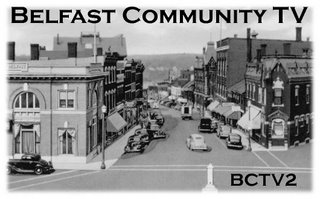
|
Support BCTV2
The BCTV2 Schedule
Belfast Community TV-Channel 2
Ned Lightner, Program Director
For community announcements:
Procedures
Click BCTV web page for our new Internet site
|
When selecting the setting for an interview try to choose a location that gives a sense of where you are. Don't hesitate to rearrange the background to eliminate distracting elements. Avoid having it appear as if a background element is growing out of the subject's head. The subject should be the brightest part of the picture, so avoid bright windows and lights in the background. If this is unavoidable, you will have to utilize the camcorder's backlight control or manual iris adjustment.
Before recording listen to the sound. Sometimes turning off a blower, closing a door or turning off a radio can make a big difference in the recording. Also set your audio level on your camcorder (if you have manual adjustment) by having the talent converse rather than saying "testing 1,2,3". Record a little "room tone". This comes in handy when you want to lift "ahs and you knows" from an interview you are editing. When positioning your subject especially if it is a two person interview, have the main subject face somewhat toward the camera, so you don't end up with profile or "ear shots". Get the "talent" to stand closer to one another than they would in non-TV situations. Space between people seems to be accentuated in video. Whenever possible, use a tripod. It is very difficult to hand hold a camcorder steadily enough so that false motion does not call attention to itself. If you must hand hold the camera, get in close to the subject and use whatever you can to brace yourself and shoot wide, and fill the frame with your subject. This minimizes any camera unsteadiness. Do not rely on automatic focus as it is easily fooled by glass, water surfaces, brightly lit background walls, and objects that are momentarily closer to the camcorder. Instead use the manual focus setting and whenever possible before recording each shot, zoom all the way in (extreme close-up), adjust the focus, then zoom back out. By performing this "hyper-focus", the subject will remain in focus at both tight and wide zoom settings. Automatic focus may be appropriate however on occasions when the action is so fast and furious that you cannot focus manually quickly enough. Keep live zooms, pans, and tilts to a minimum especially, if you are not practiced enough to do them smoothly. Never let the camera call attention to itself. No "zip" motions -- let any motion whether a pan, zoom, or tilt be at least 3 seconds in length following which the camera is steady again for at least 3 seconds. Avoid, especially, "broken" zooms where you zoom in or out, stop, zoom some more, stop, zoom some more, etc. Compose your video frame by mentally dividing the frame into thirds. A good rule of thumb is to place the subject's eyes one-third of the way down from the top of the screen. If the subject is facing left or right, give him/her some extra nose or lead room. Keep in mind that many televisions overscan and may not show as much of the scene as you see in your viewfinder or monitor. Leave about a 20% safe area around your subject. Avoid cutting off the subject at the ankles, knees, waist, chin, etc. If you will be later editing the tape, shoot some extra footage of the overall scene (establishing shots), reverse angles of the interviewer nodding or an over the shoulder shot so you can't tell what the interviewee is saying. These shots can be insert edited to cover jump cuts, poor pans/zooms, and to use as bridges from one scene to the next. If you must pause recording in an interview situation, you can avoid"jump cuts" by zooming or changing the camera angle, then resuming recording. Tips were developed by Bill Severance and Ned Lightner |
ArchivesFebruary 2006March 2006 April 2006 May 2006 June 2006 October 2006 November 2006 December 2006 January 2007 February 2007 March 2007 April 2007 May 2007 June 2007 July 2007 September 2007 October 2007 November 2007 January 2008 February 2008 March 2008 April 2008 May 2008 June 2008 July 2008 August 2008 September 2008 October 2008 December 2008 January 2009 March 2009 May 2009 July 2009 November 2009 December 2009 Site FeedSite FeedBCTV StaffInsight ProductionsBelfastBelfast Chamber of CommerceBelfast Free Library City of Belfast Waldo CountyCounty of WaldoWaldo County Village Soup MaineCommunity Television Association of MaineMaine Historical Society State of Maine ProfileAbout Us |